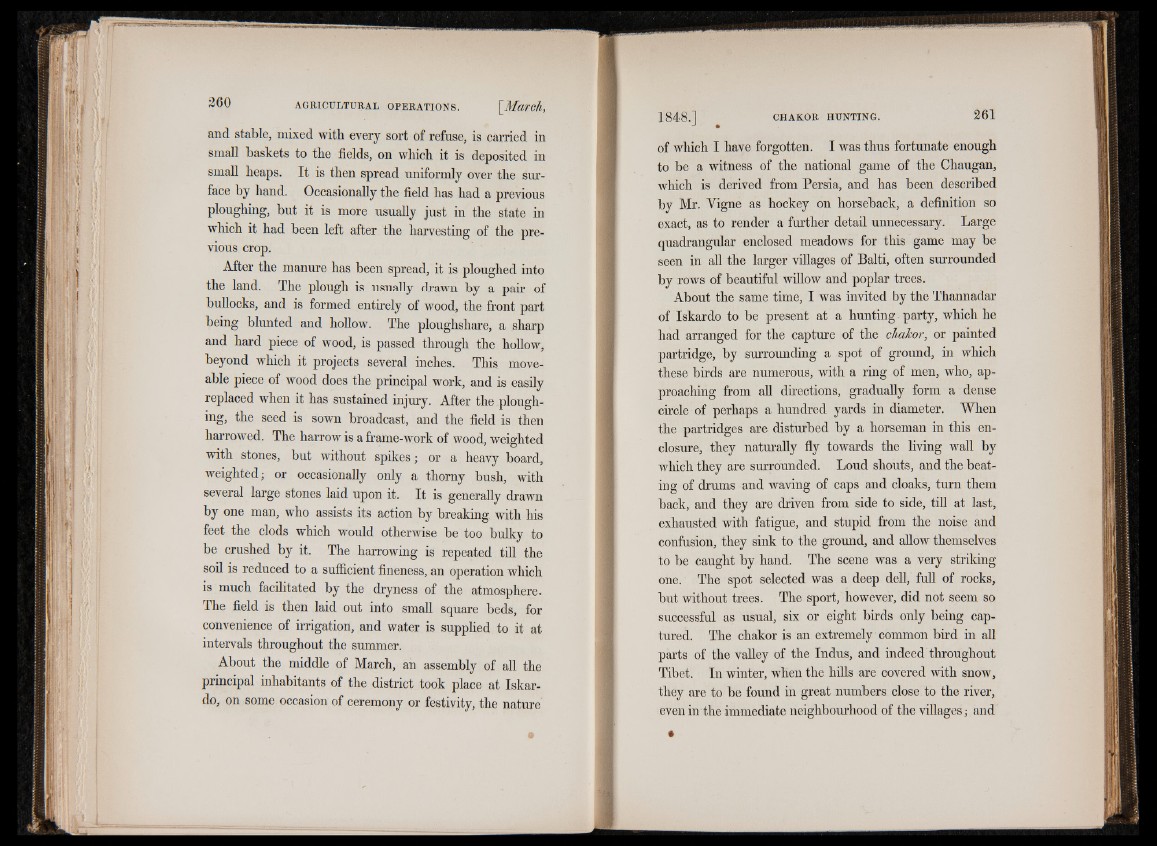
260 AGRICULTURAL OPERATIONS. [March,
and stable, mixed with every sort of refuse, is carried in
small baskets to the fields, on which it is deposited in
small heaps. It is then spread uniformly over the surface
by hand. Occasionally the field has had a previous
ploughing, but it is more usually just in the state in
which it had been left after the harvesting of the previous
crop.
After the manure has been spread, it is ploughed into
the land. The plough is usually drawn by a pair of
bullocks, and is formed entirely of wood, the front part
being blunted and hollow. The ploughshare, a sharp
and hard piece of wood, is passed through the hollow,
beyond which it projects several inches. This move-
able piece of wood does the principal work, and is easily
replaced when it has sustained injury. After the ploughing,
the seed is sown broadcast, and the field is then
harrowed. The harrow is a frame-work of wood, weighted
with stones, but without spikes; or a heavy board,
weighted; or occasionally only a thorny bush, with
several large stones laid upon it. It is generally drawn
by one man, who assists its action by breaking with his
feet the clods which would otherwise be too bulky to
be crushed by it. The harrowing is repeated till the
soil is reduced to a sufficient fineness, an operation which
is much facilitated by the dryness of the atmosphere.
The field is then laid out into small square beds, for
convenience of irrigation, and water is supplied to it at
intervals throughout the summer.
About the middle of March, an assembly of all the
principal inhabitants of the district took place at Iskar-
do, on some occasion of ceremony or festivity, the nature
of which I have forgotten. I was thus fortunate enough
to be a witness of the national game of the Chaugan,
which is derived from Persia, and has been described
by Mr. Vigne as hockey on horseback, a definition so
exact, as to render a further detail unnecessary. Large
quadrangular enclosed meadows for this game may be
seen in all the larger villages of Balti, often surrounded
by rows of beautiful willow and poplar trees.
About the same time, I was invited by the Thannadar
of Iskardo to be present at a hunting party, which he
had arranged for the capture of the chaJcor, or painted
partridge, by surrounding a spot of ground, in which
these birds are numerous, with a ring of men, who, approaching
from all directions, gradually form a dense
circle of perhaps a hundred yards in diameter. When
the partridges are disturbed by a horseman in this enclosure,
they naturally fly towards the living wall by
which they are surrounded. Loud shouts, and the beating
of drums and waving of caps and cloaks, turn them
back, and they are driven from side to side, till at last,
exhausted with fatigue, and stupid from the noise and
confusion, they sink to the ground, and allow themselves
to be caught by hand. The scene was a very striking
one. The spot selected was a deep dell, full of rocks,
but without trees. The sport, however, did not seem so
successful as usual, six or eight birds only being captured.
The chakor is an extremely common bird in all
parts of the valley of the Indus, and indeed throughout
Tibet. In winter, when the hills are covered with snow,
they are to be found in great numbers close to the river,
even in the immediate neighbourhood of the villages; and